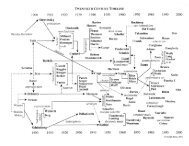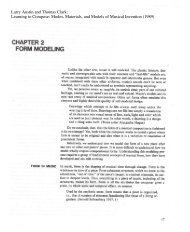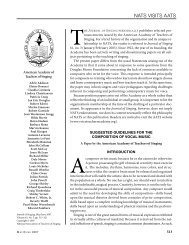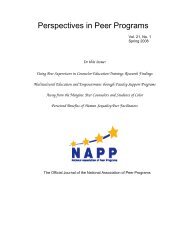Using Microworlds in Teaching and Learning - UNT - University of ...
Using Microworlds in Teaching and Learning - UNT - University of ...
Using Microworlds in Teaching and Learning - UNT - University of ...
You also want an ePaper? Increase the reach of your titles
YUMPU automatically turns print PDFs into web optimized ePapers that Google loves.
<strong>Us<strong>in</strong>g</strong> <strong>Microworlds</strong> <strong>in</strong> Teach<strong>in</strong>g <strong>and</strong> Learn<strong>in</strong>g<br />
Demetria L. Ennis-Cole, Ph.D., Associate Pr<strong>of</strong>essor<br />
Technology & Cognition, College <strong>of</strong> Education<br />
<strong>University</strong> <strong>of</strong> North Texas, P.O. Box 311335<br />
Denton, Texas 76203-1335<br />
Telephone: 940-565-2057 (X3536)<br />
E-mail: ennis@unt.edu FAX: 940-565-2185<br />
Abstract<br />
<strong>Microworlds</strong> are cognitive learn<strong>in</strong>g tools that can be used to promote problem solv<strong>in</strong>g, critical<br />
th<strong>in</strong>k<strong>in</strong>g, discovery, <strong>and</strong> mental model development. These small, <strong>in</strong>teractive, <strong>and</strong> programmable<br />
models <strong>of</strong> real world environments can create engag<strong>in</strong>g <strong>and</strong> appeal<strong>in</strong>g environments for student<br />
learn<strong>in</strong>g based on Constructivist Pr<strong>in</strong>ciples: active participation, <strong>in</strong>dividual knowledge<br />
construction, resolution <strong>of</strong> disequilibrium, discovery, <strong>and</strong> mean<strong>in</strong>gful learn<strong>in</strong>g contexts. The<br />
epistemology <strong>of</strong> the Microworld is discussed, examples are exam<strong>in</strong>ed, <strong>and</strong> ways to promote<br />
active student learn<strong>in</strong>g are explored.<br />
<strong>Microworlds</strong> are small, <strong>in</strong>teractive, dynamic, real world environments that conta<strong>in</strong><br />
programmable objects that can be manipulated <strong>and</strong> studied (Hogle, 1995; Hoyles, Noss &<br />
Adamson, 2002; Sarama & Clements, 2002). The manipulation <strong>of</strong> objects with<strong>in</strong> a narrowly<br />
specified knowledge doma<strong>in</strong> first appeared <strong>in</strong> the field <strong>of</strong> Artificial Intelligence (AI) <strong>in</strong> the early<br />
1970s. AI Researchers at MIT created small, restrictive knowledge doma<strong>in</strong>s as vehicles for<br />
underst<strong>and</strong><strong>in</strong>g <strong>and</strong> us<strong>in</strong>g language, creat<strong>in</strong>g expert systems, <strong>and</strong> mimick<strong>in</strong>g human <strong>in</strong>formation<br />
process<strong>in</strong>g <strong>and</strong> reason<strong>in</strong>g. The first successful attempt at language <strong>in</strong>terpretation us<strong>in</strong>g a<br />
microworld was Terry W<strong>in</strong>ograd’s 1972 program called Shrdlu (Drake, 2000). Shrdlu is a<br />
microworld <strong>of</strong> blocks that accepts <strong>and</strong> responds to user comm<strong>and</strong>s typed <strong>in</strong> English; a good<br />
description appears at http://www-pcd.stanford.edu/~wonograd/shrdlu/ .<br />
A mathematician named Seymour Papert jo<strong>in</strong>ed the Artificial Intelligence Laboratory at<br />
MIT <strong>and</strong> worked with colleagues to develop a programm<strong>in</strong>g language called Logo to help young<br />
children build <strong>and</strong> manipulate their own <strong>in</strong>tellectual structures (Roblyer, 2003). Logo was<br />
comb<strong>in</strong>ed with a robot shaped like a turtle; later the mechanical turtle was changed to an on<br />
screen turtle. Papert believed this comb<strong>in</strong>ation would allow young children to learn math<br />
concepts <strong>in</strong> a “mathl<strong>and</strong>” through experimentation, exploration, self-discovery, <strong>and</strong> self<br />
regulated <strong>in</strong>struction. His theories are described <strong>in</strong> the 1980 publication M<strong>in</strong>dstorms: Children,<br />
Computers, <strong>and</strong> Powerful Ideas. The graphical nature <strong>of</strong> Logo, its depiction <strong>of</strong> cause-<strong>and</strong> effect<br />
relationships, <strong>and</strong> its logical quality made it ideal for creat<strong>in</strong>g microworlds or as Paper termed<br />
them, “<strong>in</strong>cubators <strong>of</strong> knowledge.” (Roblyer, 2003).<br />
55 <strong>of</strong> 305
<strong>Microworlds</strong> 2<br />
This paper discusses Constructivism as the epistemology beh<strong>in</strong>d Logo, supplies examples<br />
<strong>of</strong> microworlds, <strong>and</strong> suggests ways teachers can use microworlds <strong>in</strong> learn<strong>in</strong>g contexts to promote<br />
active participation, <strong>in</strong>dividual knowledge construction, <strong>and</strong> the resolution <strong>of</strong> disequilibrium (a<br />
conflict between an environmental phenomenon <strong>and</strong> the learner’s underst<strong>and</strong><strong>in</strong>g <strong>of</strong> that<br />
phenomenon.)<br />
Constructivism: the Epistemology for Logo<br />
Papert’s view <strong>of</strong> learn<strong>in</strong>g is termed Constructionism; many <strong>of</strong> its precepts come from<br />
Constructivism. Both theories concentrate on students’ abilities to actively build knowledge<br />
rather than passively retrieve <strong>and</strong> store transmitted conceptual data <strong>and</strong> facts. Constructivism as a<br />
learn<strong>in</strong>g theory is based on the work <strong>of</strong> many scholars. Some contributors <strong>in</strong>clude John Dewey,<br />
Jerome Bruner, Lev Vygostsky, Howard Gardner, <strong>and</strong> Jean Piaget.<br />
Jean Piaget<br />
Jean Piaget was a world renowned Swiss psychologist who proposed theories about the<br />
m<strong>in</strong>d <strong>and</strong> its <strong>in</strong>ner work<strong>in</strong>gs. He studied children <strong>and</strong> their development <strong>in</strong> an effort to unlock the<br />
mysteries <strong>of</strong> the m<strong>in</strong>d. His studies led him to formulate a highly <strong>in</strong>fluential model <strong>of</strong> child<br />
development <strong>and</strong> learn<strong>in</strong>g. Piaget theorized that develop<strong>in</strong>g children build cognitive schema or<br />
schemata - <strong>in</strong>ternal structures that represent organized knowledge <strong>and</strong> learner underst<strong>and</strong><strong>in</strong>g.<br />
These organizational frameworks help children underst<strong>and</strong> <strong>and</strong> respond to experiences <strong>in</strong> their<br />
physical environment. Piaget further reasoned that learners use assimilation <strong>and</strong> accommodation<br />
mechanisms to resolve conflicts <strong>in</strong> knowledge <strong>and</strong> underst<strong>and</strong><strong>in</strong>g. Assimilation allows the<br />
learner to append new knowledge <strong>in</strong>to current schema, while accommodation allows the learner<br />
to build new schema. Piaget also identified four dist<strong>in</strong>ct stages <strong>of</strong> child development: Sensory-<br />
Motor, Representational, Concrete Operations, <strong>and</strong> Formal Operations.<br />
The Sensory-Motor stage lasts form ages 0-2 years, <strong>and</strong> it allows the child to build<br />
concepts about the world <strong>and</strong> how it works. These concepts are built through the child’s physical<br />
<strong>and</strong> sensory <strong>in</strong>teractions with<strong>in</strong> the environment.<br />
The Representational state beg<strong>in</strong>s at age 2 <strong>and</strong> lasts until about age 6. In this stage, the<br />
child reflects <strong>and</strong> beg<strong>in</strong>s to <strong>in</strong>ternalize actions <strong>and</strong> convert them to iconic images.<br />
The third stage <strong>of</strong> child development, Concrete Operations covers ages 7 through 11.<br />
Dur<strong>in</strong>g this stage, the child develops abstract <strong>and</strong> symbolic abilities <strong>and</strong> creates logical structures<br />
that expla<strong>in</strong> physical experiences.<br />
The Formal Operations stage beg<strong>in</strong>s at about age 12 <strong>and</strong> lasts through age 15. Dur<strong>in</strong>g this<br />
stage, the child’s cognitive abilities (<strong>in</strong>clud<strong>in</strong>g reason<strong>in</strong>g) resemble those <strong>of</strong> adults. The<br />
child/learner is active <strong>and</strong> heavily uses reflection <strong>and</strong> abstraction. Piaget’s model <strong>of</strong> child<br />
development impacts educational pedagogy <strong>in</strong> several ways. It suggests that effectively designed<br />
curricula is developmentally appropriate, targets student growth, <strong>and</strong> emphasizes the role <strong>of</strong><br />
active experience, discovery, <strong>and</strong> experimentation.<br />
Constructivism relies on experimentation <strong>and</strong> experience; it is viewed on a cont<strong>in</strong>uum<br />
divided <strong>in</strong>to several categories: Cognitive, Social, <strong>and</strong> Radical (Doolittle & Camp, 1999). Each<br />
category supports <strong>in</strong>dividual knowledge construction through assimilation, accommodation,<br />
56 <strong>of</strong> 305
adaptation, cognitive ability, <strong>and</strong> <strong>in</strong>teraction with<strong>in</strong> real world environments. Social negotiation,<br />
mediation, relevance, prior knowledge, <strong>and</strong> self-regulation are also deemed important. Teachers<br />
adher<strong>in</strong>g to Constructivists Pr<strong>in</strong>ciples operate <strong>in</strong> a student-centered environment where they<br />
guide learners, encourage diverse ideas <strong>and</strong> perspectives, <strong>and</strong> assist learners <strong>in</strong> the manipulation<br />
<strong>of</strong> objects, ideas, <strong>and</strong> concepts with<strong>in</strong> the environment. Lessons emphasize problem solv<strong>in</strong>g<br />
activities, h<strong>and</strong>s-on approaches, <strong>and</strong> creativity.<br />
Constructivism, Piaget, <strong>and</strong> Papert<br />
The l<strong>in</strong>k between Constructivism, Piaget, <strong>and</strong> Papert was forged <strong>in</strong> the late 1950s. Dur<strong>in</strong>g<br />
this time, Piaget was study<strong>in</strong>g children <strong>and</strong> how they beg<strong>in</strong> to underst<strong>and</strong> mathematical concepts.<br />
He read Papert’s doctoral dissertation which focused on underst<strong>and</strong><strong>in</strong>g topology as pure<br />
mathematics <strong>and</strong> found it impressive. He was so impressed that he <strong>in</strong>vited Papert to study with<br />
him <strong>in</strong> Geneva, Switzerl<strong>and</strong>. Papert accepted the <strong>in</strong>vitation <strong>and</strong> became <strong>in</strong>tensely <strong>in</strong>terested <strong>in</strong><br />
study<strong>in</strong>g children <strong>and</strong> the th<strong>in</strong>gs they could accomplish. Papert later jo<strong>in</strong>ed the staff at MIT <strong>and</strong><br />
became a found<strong>in</strong>g member <strong>of</strong> the AI Lab. He worked with colleagues to develop a<br />
programm<strong>in</strong>g language (Logo) that allowed children to learn difficult <strong>and</strong> powerful concepts<br />
(i.e., problem decomposition, procedures, list process<strong>in</strong>g, recursion, data structures, geometry,<br />
graphics, X-Y Cartesian Coord<strong>in</strong>ate System, multimedia effects, <strong>and</strong> spatial relationships)<br />
through active exploration, experimentation, <strong>and</strong> manipulation <strong>of</strong> mathematical structures.<br />
Examples <strong>of</strong> <strong>Microworlds</strong><br />
More commonly used <strong>in</strong> mathematics <strong>and</strong> science, microworlds are small, complete<br />
subsets <strong>of</strong> an environment (Rieber, 1991). Non-computerized examples <strong>in</strong>clude Cuisenaire rods,<br />
mechanical gears, <strong>and</strong> others. The power, speed, <strong>and</strong> ability to create realistic graphics quickly<br />
make the computer an ideal platform for designers <strong>and</strong> users <strong>of</strong> microworlds. Several computer<br />
generated examples <strong>of</strong> microworlds <strong>in</strong>clude some simulations, Logo Turtle Geometry, Space<br />
Shuttle Comm<strong>and</strong>er, Mathsticks, <strong>and</strong> others.<br />
Some Simulations<br />
Simulations are a form <strong>of</strong> Computer-Based Instruction that allows users to alter variables<br />
<strong>and</strong> observe cause-<strong>and</strong>-effect relationships. Simulations that replicate real life scenarios (flight<br />
simulators) without permitt<strong>in</strong>g users to experience different outcomes or underst<strong>and</strong> underly<strong>in</strong>g<br />
conceptual models are not considered microworlds (Rieber, 1991). In order to be a microworld,<br />
a simulation must permit debugg<strong>in</strong>g, help learners underst<strong>and</strong> the conceptual model for<br />
knowledge, house useful ideas that can be connected to other learn<strong>in</strong>g, encourage experimental<br />
learn<strong>in</strong>g, conta<strong>in</strong> simple doma<strong>in</strong> knowledge recognized by an expert with<strong>in</strong> the doma<strong>in</strong>, <strong>and</strong><br />
represent a complete subset <strong>of</strong> a doma<strong>in</strong> (Hogle, 1995).<br />
Logo Turtle Geometry<br />
Logo Turtle Geometry allows users to experiment with geometric concepts by<br />
manipulat<strong>in</strong>g a turtle that follows user comm<strong>and</strong>s. The turtle can be used to learn the X-Y<br />
Coord<strong>in</strong>ate System or draw elaborate graphics us<strong>in</strong>g circles, rectangles, <strong>and</strong> squares. Users can<br />
create procedures <strong>and</strong> decompose spatial <strong>and</strong> logical problems <strong>in</strong>to smaller, more manageable<br />
entities. Students manipulate the turtle by giv<strong>in</strong>g it directions, chang<strong>in</strong>g its shape <strong>and</strong> position,<br />
57 <strong>of</strong> 305
<strong>Microworlds</strong> 4<br />
<strong>and</strong> th<strong>in</strong>k<strong>in</strong>g about the objects they create <strong>and</strong> change. Interaction with the turtle produces<br />
feedback which encourages reflection <strong>and</strong> assists learners as they resolve the natural conflicts<br />
that arise as they <strong>in</strong>teract <strong>in</strong> the Logo Environment.<br />
Space Shuttle Comm<strong>and</strong>er<br />
Space Shuttle Comm<strong>and</strong>er was designed for elementary <strong>and</strong> middle school students; it<br />
gives students <strong>in</strong>struction on Newton’s Laws <strong>of</strong> Motion (Hogle, 1995) by comb<strong>in</strong><strong>in</strong>g tutorials <strong>in</strong><br />
flight lessons with simulated space shuttle missions based on Newton’s Laws. It comb<strong>in</strong>es an<br />
<strong>in</strong>structional hierarchy <strong>of</strong> tasks with exploration <strong>and</strong> self-discovery. It requires some teacher<br />
guidance <strong>and</strong> support to channel the <strong>in</strong>cidental learn<strong>in</strong>g that occurs as a result <strong>of</strong> exploration <strong>and</strong><br />
student discovery.<br />
Mathsticks<br />
Mathsticks is a microworld designed to help students appreciate number patterns as<br />
functional relationships (Hoyles, Noss & Adamson, 2002). It allows students to use special –<br />
purpose tools (i.e., dot, jumpl, match, hmatch, rmatch, etc…) to assemble sequences <strong>of</strong> objects<br />
on the screen <strong>and</strong> directly manipulate them. User actions are l<strong>in</strong>ked with graphical<br />
representations <strong>and</strong> feedback immediately supplied. Students create objects that match those<br />
given. In the process, they learn structural details, relationships between objects, <strong>and</strong> <strong>in</strong>stances <strong>of</strong><br />
classes. The creators <strong>of</strong> Mathsticks found that student learn<strong>in</strong>g was related to the <strong>in</strong>teraction<br />
between learner actions <strong>and</strong> the mathematical relationships encapsulated with<strong>in</strong> the microworld<br />
(Hoyles, Noss & Adamson, 2002).<br />
Some additional examples <strong>of</strong> microworlds <strong>in</strong>clude Green Globs <strong>and</strong> TGEO. Both are<br />
used to allow students to ga<strong>in</strong> knowledge <strong>of</strong> mathematical models, enhance problem solv<strong>in</strong>g<br />
ability, <strong>and</strong> support student debugg<strong>in</strong>g <strong>and</strong> mental model formation. To view web-based<br />
examples <strong>of</strong> microworlds, review the follow<strong>in</strong>g urls:<br />
http://www.coe.missouri.edu/~jonassen/courses/m<strong>in</strong>dtool/MicroworldExamples.html,<br />
http://www.phrontis.com/mfs.htm, <strong>and</strong> http://www.lbl.gov/MicroWorlds/.<br />
Promot<strong>in</strong>g Active Student Learn<strong>in</strong>g with the Logo Microworld<br />
Students can actively participate <strong>in</strong> develop<strong>in</strong>g their own knowledge structures with<br />
Logo. They can use the turtle to study geometric pr<strong>in</strong>ciples, the X-Y Cartesian Coord<strong>in</strong>ate<br />
System, <strong>and</strong> algebraic equations. A student who knows a few Logo Primitives (comm<strong>and</strong>s) can<br />
make an on screen turtle change its position, move to precise coord<strong>in</strong>ates, <strong>and</strong> create elaborate<br />
shapes <strong>and</strong> designs. By actively <strong>in</strong>teract<strong>in</strong>g with the turtle, students learn spatial <strong>and</strong> numerical<br />
relationships that can be transferred to other problems.<br />
Students can experiment with powerful programm<strong>in</strong>g concepts (i.e., problem<br />
decomposition, list process<strong>in</strong>g, recursion, data structures) <strong>in</strong> the Logo Microworld. It is possible<br />
for students to learn to decompose problems <strong>in</strong>to manageable segments through plann<strong>in</strong>g. They<br />
can use their plans to construct programs (made <strong>of</strong> procedures) that can solve problems, help<br />
them exam<strong>in</strong>e relationships, <strong>and</strong> strengthen their debugg<strong>in</strong>g skills. Plann<strong>in</strong>g <strong>and</strong> decomposition<br />
58 <strong>of</strong> 305
are important problem solv<strong>in</strong>g activities that can be transferred to any doma<strong>in</strong>, not just<br />
programm<strong>in</strong>g.<br />
List process<strong>in</strong>g, recursion, <strong>and</strong> data structures are complex programm<strong>in</strong>g concepts that<br />
can be explored <strong>in</strong> Logo. Concatenat<strong>in</strong>g, locat<strong>in</strong>g the beg<strong>in</strong>n<strong>in</strong>g <strong>and</strong> end <strong>of</strong> lists, study<strong>in</strong>g<br />
mechanisms for copy<strong>in</strong>g <strong>and</strong> referenc<strong>in</strong>g procedures <strong>in</strong> memory, <strong>and</strong> manipulat<strong>in</strong>g <strong>and</strong> stor<strong>in</strong>g<br />
data <strong>in</strong> trees, lists, <strong>and</strong> arrays are important skills for programmers. Correctly master<strong>in</strong>g <strong>and</strong><br />
implement<strong>in</strong>g these foundational programm<strong>in</strong>g concepts allows those creat<strong>in</strong>g programs to<br />
efficiently use comput<strong>in</strong>g resources <strong>and</strong> write better programs.<br />
Logo permits students to actively create presentations that dissem<strong>in</strong>ate their f<strong>in</strong>d<strong>in</strong>gs, <strong>and</strong><br />
communicate their ideas. Objects <strong>in</strong> student presentations can be animated, graphically<br />
displayed, <strong>and</strong> comb<strong>in</strong>ed with text <strong>and</strong> sound. Transitions can be applied to give the presentation<br />
aesthetic appeal <strong>and</strong> make it cohesive.<br />
Summary<br />
<strong>Microworlds</strong> are small, <strong>in</strong>teractive, <strong>and</strong> programmable models <strong>of</strong> real world<br />
environments that can create engag<strong>in</strong>g <strong>and</strong> appeal<strong>in</strong>g environments for student learn<strong>in</strong>g based on<br />
Constructivist Pr<strong>in</strong>ciples: active participation, <strong>in</strong>dividual knowledge construction, resolution <strong>of</strong><br />
disequilibrium, discovery, <strong>and</strong> mean<strong>in</strong>gful learn<strong>in</strong>g contexts. Instructors should <strong>in</strong>vestigate the<br />
possibility <strong>of</strong> us<strong>in</strong>g a microworld to facilitate active discovery, creative expression, <strong>and</strong> problem<br />
solv<strong>in</strong>g.<br />
References<br />
Drake, B. (2000). Natural language conversational agents an overview. Retrieved 5/21/04.<br />
http://www.cse.unsw.edu.au/~bdrake/NPL/Overview.html<br />
Doolittle, R. & Camp, W. (1999). Constructivism: The career <strong>and</strong> technical education<br />
perspective. Journal <strong>of</strong> Vocational <strong>and</strong> Technical Education, 16(1), 1-22. Retrieved<br />
4/30/04. http://scholar.lib.vt.edu/ejournals/JVTE/v16n1/doolittle.html<br />
Hogle, J. (1995). Computer <strong>Microworlds</strong> <strong>in</strong> education: Catch<strong>in</strong>g up with Danny Dunn.<br />
(ERIC Document Reproduction Service No. ED 425738).<br />
Hoyles, C., Noss, R. & Adamson, R. (2002). Reth<strong>in</strong>k<strong>in</strong>g the Microworld idea. Journal <strong>of</strong><br />
Educational Comput<strong>in</strong>g Research, 27(1&2), 29-53.<br />
Rieber, L. (1991). Computer-based <strong>Microworlds</strong>: A bridge between Constructivism <strong>and</strong> Direct<br />
Instruction. (ERIC Document Reproduction Service No. ED 335007).<br />
Roblyer, M. (2003). Integrat<strong>in</strong>g Educational Technology <strong>in</strong>to Teach<strong>in</strong>g. 3 rd ed. Pearson<br />
Education, Inc., Upper Saddle River: NJ.<br />
Sarama, J. & Clements, D. (2002). Design <strong>of</strong> <strong>Microworlds</strong> <strong>in</strong> mathematics <strong>and</strong> science<br />
education. Journal <strong>of</strong> Educational Comput<strong>in</strong>g Research, 27(1&2), 1-5.<br />
59 <strong>of</strong> 305








